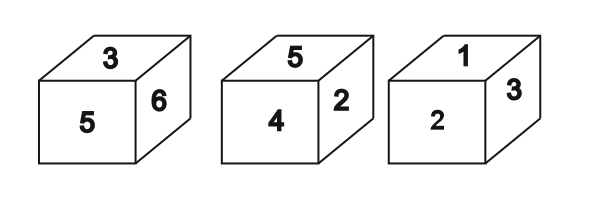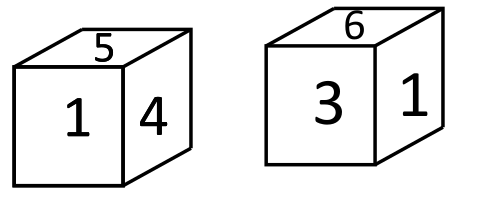Cubes and Dice Practice Question and Answer
8 Q: How many small cubes which are two surface coloured ?
751 05f57432679cfd646ddd4f932
5f57432679cfd646ddd4f932- 148false
- 264false
- 324true
- 436false
- Show AnswerHide Answer
- Workspace
- SingleChoice
Answer : 3. "24 "
Q: Four different positions of a dice are as shown below. What number is opposite to face 3?

2941 05d8daa1d1afb4111d6e49ba1
5d8daa1d1afb4111d6e49ba1
- 14true
- 23false
- 32false
- 46false
- Show AnswerHide Answer
- Workspace
- SingleChoice
Answer : 1. "4"
Q: Directions: - A cube of 7 x 7 x 7 cm. sides colored with red, green, yellow, black, pink and violet. Then it is cut into 1cm. small cubes.
Number of small cubes which have two sides colored
2304 05f157e47cf79540a75347558
5f157e47cf79540a75347558Number of small cubes which have two sides colored
- 160true
- 227false
- 349false
- 464false
- Show AnswerHide Answer
- Workspace
- SingleChoice
Answer : 1. " 60"
Q: When two dice are thrown simultaneously, what is the probability that the sum of the two numbers that turn up is less than 12? 1802 05b5cc5ffe4d2b4197774b427
5b5cc5ffe4d2b4197774b427- 135/36true
- 217/36false
- 315/36false
- 41/36false
- Show AnswerHide Answer
- Workspace
- SingleChoice
Answer : 1. "35/36"
Explanation :
Answer: A) 35/36 Explanation: When two dice are thrown simultaneously, the probability is n(S) = 6x6 = 36 Required, the sum of the two numbers that turn up is less than 12 That can be done as n(E) = { (1,1), (1,2), (1,3), (1,4), (1,5), (1,6)(2,1), (2,2), (2,3), (2,4), (2,5), (2,6)(3,1), (3,2), (3,3), (3,4), (3,5), (3,6)(4,1), (4,2), (4,3), (4,4), (4,5), (4,6)(5,1), (5,2), (5,3), (5,4), (5,5), (5,6)(6,1), (6,2), (6,3), (6,4), (6,5) } = 35 Hence, required probability = n(E)/n(S) = 35/36.
Q: Four forms of a dice are shown below. In this dice which word will be on the surface opposite to the world D?

3208 05d7f68ba5d5653223cdca5f9
5d7f68ba5d5653223cdca5f9
- 1Dfalse
- 2Atrue
- 3Bfalse
- 4Cfalse
- Show AnswerHide Answer
- Workspace
- SingleChoice
Answer : 2. "A"
Explanation :
undefined
Q: Three position of a cube are shown below. What will come opposite to face containing ‘5’?

3386 05d8daaee1afb4111d6e49efa
5d8daaee1afb4111d6e49efa
- 11true
- 23false
- 34false
- 46false
- Show AnswerHide Answer
- Workspace
- SingleChoice
Answer : 1. "1"
Q: A coloured cube is cut into smaller cubes if there are 8 colourless cubes, then how many smaller cubes are there?
2523 05e6341d8f1640a77574dc254
5e6341d8f1640a77574dc254- 164true
- 212false
- 324false
- 440false
- Show AnswerHide Answer
- Workspace
- SingleChoice
Answer : 1. "64"
Q: Two different positions of the same dice are shown. Which number will be at the top if 3 is at the bottom?

1640 05f50911a7e85226ee75078b4
5f50911a7e85226ee75078b4
- 15true
- 21false
- 34false
- 42false
- Show AnswerHide Answer
- Workspace
- SingleChoice

